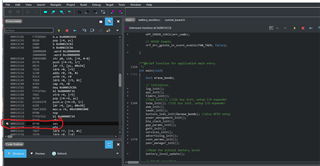I am using a Fanstel BT Module BT832F (that utilizes the Nordic nrf532832 chip). I am able to successfully run my code on Nordic's dev board PCA10040 and also Fanstel's dev board BT832F with no issues. I finally received in my custom boards and I am struggling trying to get them to run the code. I've been starting at schematics for hours and cannot see what I have missed or screwed up. I can program the chip just fine, however instead of giving me a pause at main(), and allowing me to single step through the program, it just states "running". When pausing the device, it brings me to the disassembly view and is always stuck at address 0x00015CCE with the instruction "sev".
I'm assuming it is stuck somewhere in the softdevice, or bootloader but not sure where to begin.
I first suspected (and still do) something with my low power xtal. I do have a 32.768kHz xtal in there with two 12pF caps. Putting a scope on there, it is flat lined. Digging a bit deeper, I believe I didn't spec in the proper caps/xtal and it is not loaded correctly. I have a XTAL with a 12pF load capacitance rating, where I should have an XTAL with a 9pF or so rating. I've tried swapping the XTAL out but my lack of SMD rework tools have made that a challenging task. I've also tried to change the code to use an RC clock source and still experiencing the same results. Although I'm not sure I changed it in the correct location(s).
This is my first time using Nordic tools. The library has been solid, but I feel it is a bit confusing adding in new library pieces/drivers into your project. I'm not sure if I am missing something with the softdevice or on my hardware end. Any help would be appreciated as I'm going crazy trying to figure this out.


Hopefully you can see those images. When they uploaded in my preview, they looked grainy on the conversion.
